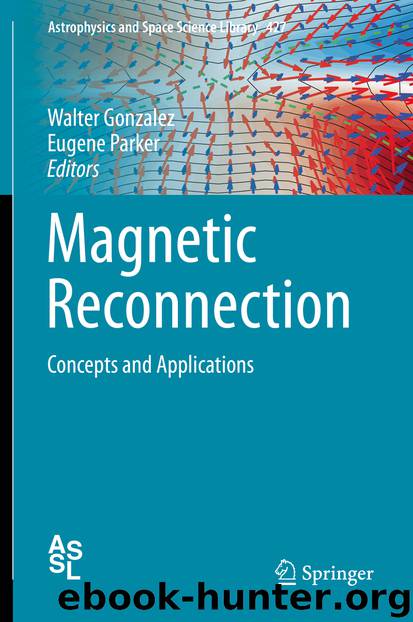Magnetic Reconnection by Walter Gonzalez & Eugene Parker

Author:Walter Gonzalez & Eugene Parker
Language: eng
Format: epub
Publisher: Springer International Publishing, Cham
Keywords
Current sheetMagnetospheric reconnectionMagnetotailPlasma sheetReconnection onsetSubstorms
7.1 Introduction
In the Solar system, the Earth’s magnetosphere is a unique example of a fair balance between external driving and inherent dynamics. Mercury, Venus, and Mars magnetospheres are almost entirely driven by solar wind, while that of the giant planets are dominated by rotation effects. Solar wind flow shapes the Earth’s magnetosphere, however global convection inside the magnetosphere is largely determined by the interplanetary magnetic field (IMF). This convection is substantially mediated by the relatively strong Earth’s magnetic field, in particular through cycles of solar wind energy accumulation and release, known as substorms. Substorms, producing auroras and geomagnetic variations at polar latitudes, are the most spectacular everyday manifestation of magnetospheric dynamics and space weather in general.
The magnetotail plays the central role in substorm dynamics. The magnetotail includes the plasma sheet, filled with the hot plasmas on the closed magnetic field lines with both their ends in the ionosphere, and the tail lobes with empty open field lines, having one end in the Earth’s polar cap ionosphere and another connected to interplanetary magnetic field (IMF). The current sheet (CS) here is introduced qualitatively as a zone in the plasma sheet, in which the major part of magnetic field reversal occurs.
Already, early spacecraft observations revealed that substorms are associated with southward IMF (B z < 0, GSM frame is used hereafter). Substorms start with gradual accumulation of open magnetic flux in the lobes, thinning and stretching of plasma sheet (growth phase). At a substorm onset, the expansion phase starts with a rapid decrease of magnetic flux and dipolarization (a return to a more dipolar configuration of the magnetic field) of plasma sheet, coincident with auroral brightening and geomagnetic variations on the ground (McPherron et al. 1973; Baker et al. 1996, and references therein).
Historically, two scenarios of solar wind effect on the magnetosphere were proposed: viscous interaction supported by various diffusive-like processes at the magnetospheric boundary (Axford and Hines 1961) and reconnection of IMF lines and geomagnetic field lines at the dayside magnetopause and in the magnetotail (Dungey 1961). Though spacecraft observations demonstrate elements of both scenarios (Wing et al. 2014), magnetic reconnection is of primary importance for substorms and for magnetospheric dynamics in general (Paschmann et al. 2013).
When the IMF is directed southward, it reconnects with field lines of the Earth magnetic field at the day-side magnetopause (see Chap. 3 in this book). This process can be considered as a forced reconnection, as interplanetary magnetic field frozen into the solar wind plasma flow collides with the Earth dipole field and has no chance to avoid reconnection in case when two field lines are directed approximately opposite to each other. Thus, the basic dynamics of the magnetopause reconnection may be essentially controlled by external (i.e. boundary) conditions.
The situation is different for the reconnection in the tail (Fig. 7.1). First of all, simple estimates show that the global convection forms the night-side reconnection region around 100–200 R E downtail (distant neutral line, DNL). Motion of solar wind plasma V sw with frozen-in IMF B IMF corresponds to the electric field .
Download
This site does not store any files on its server. We only index and link to content provided by other sites. Please contact the content providers to delete copyright contents if any and email us, we'll remove relevant links or contents immediately.
The Complete Stick Figure Physics Tutorials by Allen Sarah(7134)
Secrets of Antigravity Propulsion: Tesla, UFOs, and Classified Aerospace Technology by Ph.D. Paul A. Laviolette(4973)
Thing Explainer by Randall Munroe(3782)
The River of Consciousness by Oliver Sacks(3409)
The Order of Time by Carlo Rovelli(3071)
How To by Randall Munroe(2911)
I Live in the Future & Here's How It Works by Nick Bilton(2839)
A Brief History of Time by Stephen Hawking(2818)
What If?: Serious Scientific Answers to Absurd Hypothetical Questions by Randall Munroe(2542)
The Great Unknown by Marcus du Sautoy(2532)
Midnight in Chernobyl by Adam Higginbotham(2384)
Blockchain: Ultimate Step By Step Guide To Understanding Blockchain Technology, Bitcoin Creation, and the future of Money (Novice to Expert) by Keizer Söze(2377)
Networks: An Introduction by Newman Mark(2264)
The Meaning of it All by Richard Feynman(2213)
Easy Electronics by Charles Platt(2204)
The Tao of Physics by Fritjof Capra(2162)
Midnight in Chernobyl: The Untold Story of the World's Greatest Nuclear Disaster by Adam Higginbotham(2074)
When by Daniel H Pink(2019)
Introducing Relativity by Bruce Bassett(2015)
